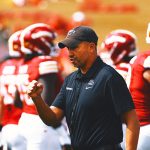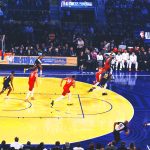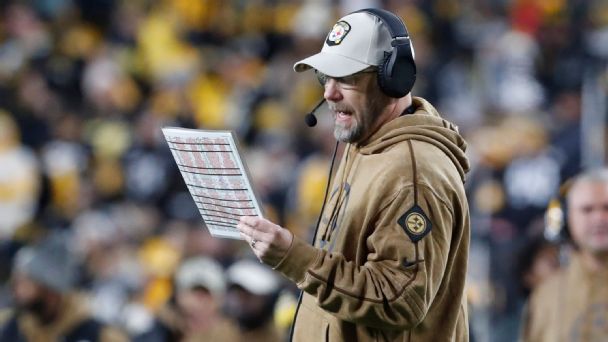
PITTSBURGH — Minutes before kickoff on Thursday night against the Tennessee Titans, Matt Canada exited the Pittsburgh Steelers’ locker room at Acrisure Stadium and turned right. In each of the other 21 games Canada has served as the Pittsburgh Steelers‘ offensive coordinator, he turned left out of the locker room, heading down the hallway and to the elevator up to the fourth-level coaches’ booth.
But for the first time since he was Maryland’s interim head coach in 2018, Canada left the pregame locker room meeting and went to the sideline with a playsheet in hand to call from field level.
Though Canada downplayed the move, Steelers players were unanimous in the positive impact it had on the offensive communication in the 20-16 win. Against the Green Bay Packers on Sunday, Canada will remain on the sideline to call plays.
“I think there’s an advantage to it,” wide receiver Allen Robinson II said. “He’s there, so he’s talking to us. We’re kind of talking through different things and stuff like that, but in the NFL setting, whether the offensive coordinator is upstairs or not, you have a ton of communication that’s coming in, drive to drive, play to play and different things like that.”
In relocating to the sideline, Canada and the Steelers are moving to a format used by the majority of the league. Of the 20 play-calling offensive coordinators, 16 operate from the sideline. And while the move doesn’t necessarily correlate directly with higher-scoring, more consistent offenses, coordinators and players across the league agree being on the sideline offers an intangible boost to the offense and to player development.
“I think you get a true feel for the environment,” Titans offensive coordinator Tim Kelly said. “You get a feel for your guys up front when they’re running off the ball, when they’re surging, if you will. I think you get a feel for the big fella [Derrick Henry], right? You feel him run and then being able to have that immediate feedback within him, the dialogue, the back and forth, one of the benefits to being on the field.
“And there’s drawbacks too. Obviously when you’re up top you get to see more and you’re kind of taken away from the emotional part of the game, if you will. So there’s pros and cons to everything.”
For the Steelers, the decision to move Canada from the booth to the sideline came as coach Mike Tomlin analyzed every variable contributing to the team’s offensive inconsistency. Though Tomlin said the timing of the decision was “irrelevant,” and declined to say when it was made, it’s notable that the Steelers made a seemingly big change during a short week.
“We’re willing to do whatever’s required to continue to progress in all three phases,” Tomlin said. “We make changes week-in and week-out obviously because of his location. That was a more obvious change, but I thought there were good reviews. I thought it aided in communication. Coach-to-player is one thing, but the give and take and the face-to-face component I thought could add a little value to our calls. … We’ll probably continue to turn other things over in an effort to continue to improve. We do things weekly. Some weeks you notice ’em, most weeks you don’t.”
Previously, only QB Kenny Pickett communicated directly with Canada during games. Not only did Canada give Pickett the play through in-helmet communication, but Pickett also used the telephone system that connected him to the booth after a drive. Other times, Canada’s observations were relayed to Pickett through quarterbacks coach Mike Sullivan and to the rest of the offense through their respective position coaches.
“You don’t [have] to play telephone,” wide receiver Diontae Johnson said. “Just go straight up to him. Tell him whatever you need to say.”
When Pickett came out of the game between drives, he took a seat between Canada on the bench and Sullivan perched on an orange water cooler. With a tablet, Pickett and his coaches quickly went over the film of the previous drive.
“I think the communication between me and Coach [Canada] was great,” Pickett said. “After we had our conversation on what we want to do the next series, he was able to go talk to each position group and kind of give ’em what we’re looking to do that next drive. I think that was huge. There’s a lot of positives that came away from it. I think we can continue to build on that.” Across the field from Canada in Pittsburgh last week, Kelly’s spot on the sideline gave him the perfect opportunity for an impromptu teaching moment with quarterback Will Levis after the rookie’s fourth-quarter interception.
0:58
McAfee shocked hearing ‘fire Canada’ chants at Ohio State
Pat McAfee is surprised hearing the Ohio State fans chanting “fire Canada” in reference to Steelers offensive coordinator Matt Canada.
“I was waiting for it to come up on the JumboTron to get a look at it,” Kelly said, “… and when he came over, luckily it came on the screen and we were kind of able to have a mini film session, if you will.”
Of course, being on the sideline means a different vantage point for calling plays, and coaches on the sideline rely on the assistants who remain in the booth to relay their perspective throughout the game. In Green Bay, coach Matt LaFleur calls plays from the sideline, but he recently shifted offensive coordinator Adam Stenavich from the sideline to the booth.
“Matt wanted me to be up there,” Stenavich said. “Kind of wanted me to have a different perspective. … I think he just kind of wanted me to look more at the secondary, things like that.”
Before his move to the sideline, Canada was one of few NFL playcallers who coached from the booth.
Only Jacksonville’s Press Taylor, Buffalo’s Ken Dorsey, the New York Giants’ Mike Kafka and Baltimore’s Todd Monken are offensive coordinators who call plays from the coaches’ box. As a first-time offensive coordinator when he arrived in Jacksonville in 2022, Taylor debated the merits of working from each location. He ultimately chose the booth, and after calling plays on a limited basis in his first season, Taylor’s been the Jaguars’ full-time play-caller this year.
“I do like being upstairs in the box a little bit,” Taylor said. “I can spread everything out, I can clear my mind a little bit more. It’s quiet, it’s calm up there. I enjoy being up there.”
There are, of course, challenges to being in the booth. Not only can it limit in-game conversations with the entire offense, it also comes with a sometimes less-than-flattering spotlight courtesy of the TV cameras trained at the booth to capture the coordinators at work. In at least two games this season, Canada was the subject of social media scrutiny after cameras captured his nonchalant reaction to two Steelers touchdowns.
Matt Canada sideline touchdown celebration: “Let’s f-king go.” pic.twitter.com/Rud1LmDBDC
— Andrew Fillipponi (@ThePoniExpress) November 3, 2023
Thursday night, though, cameras caught a different kind of reaction. Canada celebrated on the sideline as the Steelers scored their first opening drive touchdown since Week 15 of the 2022 season.
“It’s good to see his emotions, see him excited, good for him to see us excited,” Steelers center Mason Cole said. “I think it worked well for us, I don’t know if it’s because he was on the field or not, but I’m sure we’ll keep rolling with it.”
Reporting from ESPN’s Rob Demovsky, Michael Di Rocco and Turron Davenport contributed to the story












